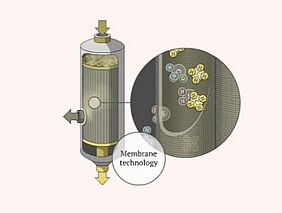Hydrocarbon separation is one of the most complex and important processes in industrial hydrocarbon production because it generates a multitude of chemicals which are important to national economies. Commercial separation technologies, such as cryogenic distillation or solvent extraction, consume a lot of energy and cause serious environmental damage. Also, the growth of industrial processes and technologies as well as the overall increased product requirements concerning for example its purity cause problems that cannot be solved using traditional separation methods. Membrane-based separation methods have found to be energy-efficient alternatives which can possibly improve the current energy-intensive conditions and satisfy the new demands, as practical membranes should have high permselectivity at industrially relevant high pressures and under aggressive conditions, and be manufacturable in a scalable and robust fashion.
Now (2021), an international team of scientists combined their efforts and designed a electrochemical directed-assembly strategy to produce polycrystalline metal–organic framework membranes for the separation of hydrocarbons. For this purpose, a series of face-centred cubic metal–organic framework membranes lodged on 12-connected rare-earth or zirconium hex nuclear clusters with distinct ligands were created. The resultant fumarate-based membranes consisting of contracted triangular apertures as sole entrances to the pore system were suitable for application in molecular-sieving separation of propylene/propane and butane/isobutane mixtures. Especially by increasing the feed pressure to the industrially practical value of 7 atmospheric pressure led to the intended increase in the total flux as well as separation selectivity. Process design analysis demonstrated that for propylene/propane separation the use of such face-centred cubic Zr-fumarate-based metal–organic framework membranes in a hybrid membrane–distillation system was responsible for a decrease in the energy input by nearly 90% compared to a conventional single distillation process.
A lot of research has been carried out so far to make hydrocarbon processes more sustainable. In 2017, scientists designed propylene transport membranes containing silver nanoparticles, which produced propylene of 99.6% purity with 97% recovery for 46,000 kg/h capacity. They optimised the distillation process using a stochastic solver in combination with a commercial process simulator. With the distillation process, the energy and total costs amounted to approximately $4.40 to produce per ton of propylene, respectively. The results suggested that required membrane permeance and selectivity was between 11.3 to 251.5 gas permeance unit depending on stage-cut. A sensitivity analysis was also performed according to membrane costs, feed flow rates and composition.
In 2021, scientists collected and analysed the data from neat polymers and mixed matrix membranes (MMM) for propylene/propane separations. In order to improve the properties of polymer membranes, MMM were developed containing an inorganic filler and a polymer matrix which enabled improved performances with a synergistic effect. However, scientists found that these performances strongly depended on the filler type and content, as well as their compatibility. In view of the results available, the scientists concluded that increased development efforts would surely lead to improved performances for industrial-scale applications in the petroleum industries.
There are several advantages to membrane-based separation processes: they can outperform competing technologies, including e.g. pressure swing absorption, cryogenic distillation, adsorption, evaporation and crystallization. Also, especially membrane gas separation does not use any moving parts, has small carbon footprint and the system is very compact. Its operation is flexible concerning feed fluctuations and demands comparatively lower energy leading to lower operating costs. Moreover, the process does not involve chemicals or solvents and it requires minimal maintenance and operator attention.
In a world where energy effective as well as low cost production processes are becoming increasingly important, membrane processes, which are generally comparatively low-cost, will become ever more attractive. In view of this, the polycrystalline continuous metal-organic framework might make a valuable contribution to making oil production and processing more sustainable.
